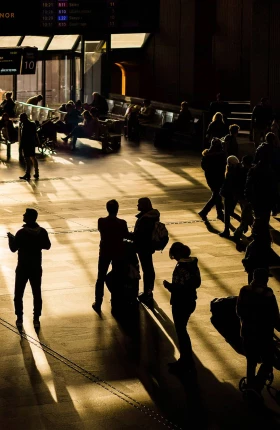Is there a safe way for governments to reopen their borders—not only to neighbors but to those half a world away?
That’s a question that’s getting a lot of attention from heads of state, border security officials, and economic ministers. In recent months, every destination in the world has implemented significant international travel restrictions—often with devastating consequences for their economies.
The most obvious casualties have been the aviation and tourism industries, but there has been a lot of collateral damage, including risks to domestic university systems that rely on income from international students and to food producers that depend on migrant workers. The border closings—partial or full—that have come in response to COVID-19, and the suspension of international travel between many points, have removed a crucial underpinning of world trade.
Border reopenings must be done in ways that make travelers feel confident about being in a country that’s not their own.
As countries think about opening back up to visitors who might be coming on flights of 8, 10, or 12 hours’ duration, they face a daunting set of tradeoffs and logistical questions. The coronavirus is not like other natural disasters, where the route to recovery is clear and the issues are mostly related to resources and marshaling the will of a nation or region. Border reopenings amid this pandemic are going to require coordination with other countries and with domestic industries that enable, or depend on, international travel. The reopenings must be done in ways that make travelers feel confident about being in a country that’s not their own. Delays and missteps—there will inevitably be some—will be extremely costly if countries don’t build effective border biosecurity regimes.
Keys to Reopening
Here are the four key steps that governments must take.
Measure Economic Benefit Against the Risk to Your Population
Restarting your long-haul flight system should not be an all-or-nothing proposition, with all countries or no countries on the approved list. The decision about which travelers to let in should be based on two factors: the value of specific foreign visitors to your country and the risk that they could trigger new outbreaks of COVID-19 in your towns and cities.
Foreign visitors’ value is a function of the direct contribution they make to your gross domestic product by being in your country (whether by supporting aviation or tourist industries, providing income to educational institutions, or partnering with domestic businesses). These visits may also have a societal value—such as maintaining family contacts—or a value rooted in other bilateral considerations. The bilateral considerations may relate to countries’ cultural ties or shared security interests.
Against these positives, governments must weigh the health risks. This requires an analysis of several factors, including the infection rate in the origin country; the confidence you have in the origin country’s ability to test, track, and trace; and the maturity of your own biosecurity regime. This last consideration—your own biosecurity regime—is critical because it is inevitable that, after you open up to more travelers, someone coming to your country will be an asymptomatic carrier of the disease. At this point in the history of COVID-19, countries have no way to guarantee that they will never have another infection.
Decisions about how to treat different countries’ visitors should be made after weighing these tradeoffs. (See Exhibit 1.) And they needn’t be treated as permanent decisions. The hurdles to visiting your country can be raised—or lowered—as the battles with COVID-19 in a traveler’s origin country progress or regress.
From a practical perspective, this may mean that the restrictions on people from countries with excellent biosecurity measures and low disease levels could be light now—and stepped up later if a country has a new outbreak. The restrictions will almost certainly need to be higher for travelers whose itineraries include a stop at a major airport hub: that’s another place where they could get infected. Point-to-point flights, for now, are easier to secure.
With so much information to convey to would-be visitors—and because of the nonstatic nature of the health risk—border officials may want to set up a system of color codes (agreed between countries) to signal biosecurity levels. As an example, the system could categorize flights as follows:
- Green: Few or no biosecurity requirements are imposed.
- Blue: Limited biosecurity measures are required prior to travel—perhaps just a need for passengers to show travel history for the previous two weeks.
- Yellow: This higher level of risk might trigger a requirement for a fresh COVID-19 test for all passengers before boarding.
- Orange: Two tests—one in the origin country and another at your border—along with self-quarantines upon arrival might be needed.
- Red: Passengers on these flights, in the highest biosecurity risk category, might have mandatory two-week quarantines upon arriving on your shores.
A clear risk categorization system like this could provide valuable information to officials, to airport and airline personnel, to travel agents, and to travelers themselves.
Collaborate Closely with Industries That Have the Most at Stake
Global tourism stopped abruptly when the pandemic hit. The companies involved in tourism—hospitality, resorts, cruise ship operators—have a big incentive, now, to partner with governments in order to restart international travel. So do airlines and airports in the many parts of the world where airports are privately owned.
The risk of infection on airplanes is already relatively low compared with other forms of transport. People don’t face one another when seated on flights, and airlines’ use of pressurized cabins and refreshed air (through HEPA filters) provides a line of defense against airborne disease transmission. But the risk isn’t zero. This is why airlines are looking at additional steps and taking new precautions.
Governments will likely have their own ideas about what the airlines should do to guard against outbreaks back home. These ideas, however, can’t be at odds with the realities of airline economics.
For example, an overly draconian requirement for social distancing onboard planes would threaten airlines’ ability to operate—and complicate their participation in a restart process. The airlines can’t and shouldn’t accept steps that would make it impossible for them to break even. But they could make or operationalize other biosecurity investments, among them the refurbishment of airports to enable additional border health checks.
Take the Traveler’s Perspective
All your planning will be useless if the prospect of visiting your country is daunting—for instance, if it’s known that people suspected of carrying the virus are required to quarantine in makeshift facilities at your airports. Likewise, few visitors will come to your country if they see a chance of getting stuck there.
It will be an equally big disincentive if would-be travelers know that the biosecurity measures in your country aren’t as rigorous as those in their own country (as might happen if mask wearing is mandated and universal in their country and optional in yours).
These psychological factors are everywhere these days. In many countries and cities, consumers have been reluctant to return to shops and restaurants even after restrictions have been lifted. In response, many businesses have taken to posting notices about the policies they’re adopting to keep customers safe.
While this has been mostly a ground-up effort aimed at local customers, it could also become a top-down push in countries looking to rejuvenate their leisure and business tourism sectors.
Think of it this way: Those planning a visit to your country may well be concerned about the risks they will be facing. They will look for visible indications that your country has made public health a priority. One such indication could be the amount and type of testing you require travelers to undergo in order to pass through your security checkpoints; another could be your use of contact-tracing software (a controversial requirement that—if used—will have to be managed carefully).
Simple signage also plays a role. Your transportation systems, outdoor recreation areas, and shopping and dining districts are all good places to post advertisements about policies and expected behavior. This kind of communication (as well as the training of travel agents and of airport and airline staff) will likely be important for at least the next two years. Beginning the communication now could help you scale it up later.
Another dimension that’s important to consider is travelers’ willingness to share in the costs of your new biosecurity processes. Airline passengers, in particular, might accept additional costs. But the inverse correlation between ticket prices and passenger numbers is a reality that can’t be ignored. There’s an amount above which so few people would travel that it would eliminate any chance of economic benefit.
Use a Layered Approach
The stages of international air travel—getting to an airport, finding the right gate, the flight itself, the process of going through security at the destination country, and the time spent in the destination country—provide multiple chances for a traveler to contract the virus. It can’t be assumed that people who are healthy when they leave their home in one country will still be healthy when they get to where they are going 5,000 miles away. (See Exhibit 2.)
For this reason, governments should put in place a layered approach to biosecurity in order to mitigate the risk that an incoming traveler will cause a new outbreak in their countries. Here’s a look at where infections can happen—and how to diminish those risks.
In the origin country. You have a limited amount of control over the risk mitigation practices of foreign governments. But from a policy perspective, you could simplify travel from countries that follow practices similar to your own. It might even be possible to set up bilateral agreements with these countries—the sort of “common corridor” policy that Australia and New Zealand are considering, with the trans-Tasman bubble, for the relatively short trips between their countries.
By contrast, if a country has a sharply higher incidence of COVID-19 than your own, you could require that country’s travelers to take coronavirus tests before boarding planes at their airports (or show a certificate proving they’ve had a recent test). Another way of achieving the same thing would be through the use of thermal tests or temperature checks in the origin country’s airports. These tests, it’s true, are of questionable accuracy. But they might have a deterrent effect for people who have recently developed an unexplained symptom, if they know there is a chance of being stopped before boarding a plane. (See the sidebar, “No Perfect Way to Keep Out Travelers with COVID-19.”)
No Perfect Way to Keep Out Travelers with COVID-19
No Perfect Way to Keep Out Travelers with COVID-19
Should destination countries accept the COVID-19 tests that arriving passengers take in another country? If countries require a fresh test for someone arriving at one of their airports, which kind of COVID-19 test should they use—a fast but less reliable test or a more accurate test that could take hours to produce an answer?
These are among the questions that destination countries (also called receiving countries) must answer as they look to more fully reopen their borders. There isn’t a single decision that doesn’t involve some sort of tradeoff.
For instance, from the standpoint of information certainty, it would obviously be better if border officials knew that someone was—or was not—infected with the virus. But if the time required to get accurate results were too long, a person could be exposed to COVID-19 at the receiving country’s airport while waiting for the test results. In that case, a push for certainty would backfire.
Destination countries also need some level of confidence in the testing regimes of origin countries, airlines, and airports. It would be too complex to independently audit or approve the testing facilities of origin countries.
Another potential requirement could be that the traveler hadn’t recently been in a country with a high incidence of the disease. This could be verified through data on an e-passport.
In transit and in the air. This is another leg of the trip that must be secured. More safety is possible if airports require social distancing at their terminals and if passengers and crew onboard flights use personal protective equipment. Other steps can also be taken to increase the safety of flights, including enhanced cleaning of the plane’s interior surfaces (as many airlines are already doing) and restricting the movements of passengers aboard flights. Eventually, it may be possible to test tank wastewater for evidence of COVID-19—with a positive result triggering contact tracing and potentially other actions.
Any new steps need to be financially manageable for both airlines and airports.
At your own airport checkpoint. You may want to require people coming from certain foreign countries to take a COVID-19 test when they arrive at your border checkpoint (even if they have taken a test less than 24 hours before, in a different country’s airport). If your tests don’t provide an immediate negative or positive result, you’ll have to decide whether to quarantine travelers while they wait for the results (and where they would wait). If an incoming visitor tests positive, you need to have separate protocols for dealing with fellow travelers, flight crew, and airport workers.
Individual and mass temperature screenings are another tactic that can build traveler confidence (notwithstanding the accuracy question mentioned earlier).
Once in your country. It may make sense to ask travelers to use track-and-trace apps, at least for the first 14 to 28 days that they are in your country. This is a tricky requirement, partly because of technical challenges involving the software and phones foreign travelers might be using—and partly because of objections that travelers’ own border officials could have to them returning with an app they downloaded in your country. Still, it’s worth looking at whether there might be a way to do this. Singapore and Australia, for instance, have developed systems that track proximity (who an infected person has been near) instead of location, thus addressing a big privacy concern. The systems are designed to automatically stop functioning—and be deleted—after 25 days.
Another idea is that of ring-fencing visitors’ movements: asking them to limit their activities to previously agreed upon counties, states, or provinces. If travelers have an organizational sponsor for their trip—a university or business—the sponsor could even assume some responsibility for where the travelers go once inside your country.
Of course, the feasibility of restrictions like this remains to be seen. Enforcing them could be unrealistic for many countries. And the idea itself could be contrary to the spirit of discovery that is central to some countries’ leisure tourism industries.
Remaking Your Border Biosecurity Regime
It’s not news that most countries were unprepared for a pandemic. Traditionally, border biosecurity efforts have been focused on plants and animals and often run by countries’ agriculture departments. The regimes aren’t set up—from the standpoint of expertise, technology, or staffing—to hold back a human-transmitted disease.
The challenges of border biosecurity, in the era of COVID-19, are immense. They begin with what’s still unknown about the disease and about our mechanisms for diagnosing and treating it. In particular, there are still a lot of questions about how easy it is to detect the coronavirus in people who show no visible symptoms, about all the ways the disease can spread, and about the sensitivity and specificity of different tests.
International flights categorized by their COVID-19 risk—yellow, orange, red—could become part of a new reality.
Designing and executing an effective border biosecurity regime involves many things. On the institutional level, it means deciding on the governance structure you will use—who is going to be responsible for running which areas. You must take complex health advice into account, manage your testing capacity and supply, and modernize your border management processes and technology.
The policy framework for dealing with the coronavirus threat should be flexible. Countries must develop tools to continually monitor the risk profiles of different countries and traveler segments. And they must work out mechanisms for sharing this information with airlines, airports, and other entities in the travel chain. The data should be sophisticated and real-time—or as close to real-time as possible. If a given route needs to undergo a policy change (an increased layer of testing, say) that change should be implemented quickly and with as little confusion as possible. The color coding we’ve already discussed could be helpful with this kind of signaling. We could see it being the responsibility of airlines, three days prior to a flight, to update passengers about the flight’s biosecurity level and tell them what they need to do in order to travel.
Then too, the wider situation is not static. The technology will evolve. COVID-19 testing, including the tests being administered in airports, may be much more reliable within a few months. That would make it easier to identify the right tradeoffs and contain the exposure risks inherent in long-haul flights.
No matter what you do, though, you won’t be able to completely eliminate risk once you open your borders to travelers from more parts of the world. The key when that time comes won’t be avoiding all infections brought from the outside—it’ll be limiting the spread from the infected travelers who get through.
We feel sure the day will come when COVID-19 will be a distant memory: a health problem that the world conquered, in one way or another. Still, countries need to be ready for the next global health crisis. Business, education, the world’s food supply—everything is interconnected now. This is the time for countries to rethink their border biosecurity regimes. Your citizens’ health (physical, financial, emotional) and the health of some of your most important industries hang in the balance.













